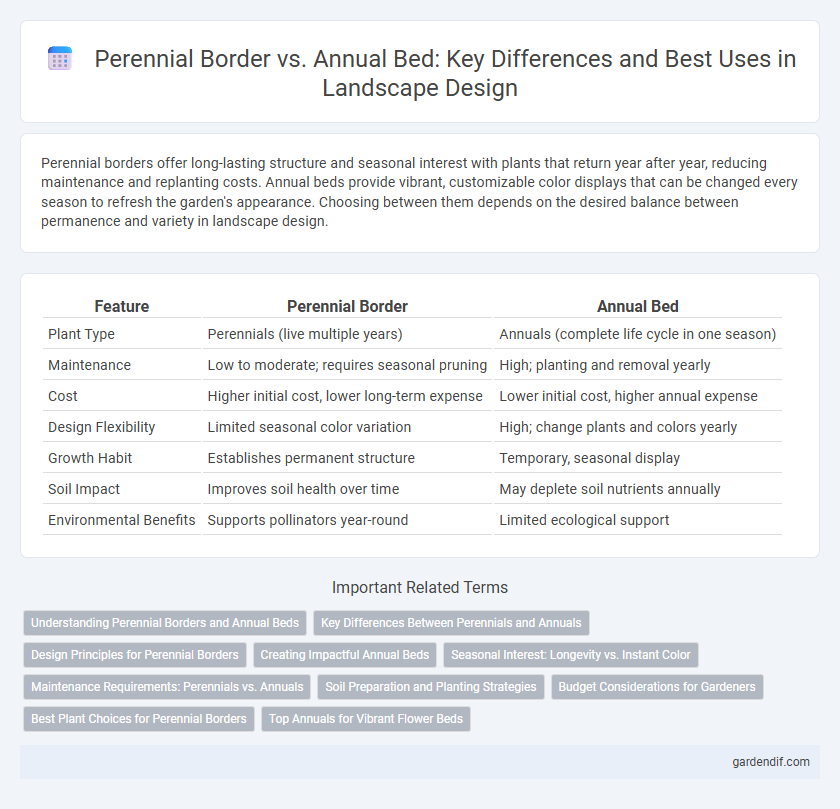
Perennial Border vs Annual Bed Illustration
Perennial borders offer long-lasting structure and seasonal interest with plants that return year after year, reducing maintenance and replanting costs. Annual beds provide vibrant, customizable color displays that can be changed every season to refresh the garden's appearance. Choosing between them depends on the desired balance between permanence and variety in landscape design.
Table of Comparison
| Feature | Perennial Border | Annual Bed |
|---|---|---|
| Plant Type | Perennials (live multiple years) | Annuals (complete life cycle in one season) |
| Maintenance | Low to moderate; requires seasonal pruning | High; planting and removal yearly |
| Cost | Higher initial cost, lower long-term expense | Lower initial cost, higher annual expense |
| Design Flexibility | Limited seasonal color variation | High; change plants and colors yearly |
| Growth Habit | Establishes permanent structure | Temporary, seasonal display |
| Soil Impact | Improves soil health over time | May deplete soil nutrients annually |
| Environmental Benefits | Supports pollinators year-round | Limited ecological support |
Understanding Perennial Borders and Annual Beds
Perennial borders consist of plants that return year after year, offering long-term structure, seasonal variation, and reduced maintenance compared to annual beds. Annual beds require replanting each season, providing opportunities for changing color schemes and plant varieties but demanding more frequent upkeep. Choosing between perennial borders and annual beds depends on desired garden longevity, maintenance commitment, and design flexibility.
Key Differences Between Perennials and Annuals
Perennials return year after year, developing deeper roots and increasing in size over time, making them ideal for long-term landscape structure and stability. Annuals complete their life cycle in a single growing season, providing vibrant, seasonal color and allowing for quick design changes with each planting. Key differences include lifespan, root development, maintenance requirements, and seasonal impact on garden aesthetics.
Design Principles for Perennial Borders
Perennial borders enhance landscape design by providing structure, texture, and seasonal interest through layered planting of long-lasting species such as coneflowers, hostas, and daylilies. Emphasizing plant height, color harmony, and bloom succession ensures continuous visual appeal while minimizing maintenance compared to annual beds that require yearly replanting. Integrating complementary foliage and varying bloom times in perennial borders promotes biodiversity and sustainable garden ecosystems.
Creating Impactful Annual Beds
Creating impactful annual beds involves selecting vibrant, fast-growing plants that provide continuous color throughout the growing season, unlike perennial borders which develop gradually over years. Annual beds allow precise control over color schemes and design themes, making them ideal for dynamic, seasonal displays in both residential and commercial landscapes. Maximizing soil preparation and incorporating high-quality organic matter enhances plant health and bloom longevity, ensuring a striking visual impact.
Seasonal Interest: Longevity vs. Instant Color
Perennial borders offer long-lasting seasonal interest by providing evolving textures and colors throughout multiple seasons, enhancing garden stability and growth over years. In contrast, annual beds deliver instant color and dramatic visual appeal, ideal for quick garden transformations and vibrant, short-term displays. Choosing between the two depends on the desired balance between enduring landscape structure and immediate, dynamic floral impact.
Maintenance Requirements: Perennials vs. Annuals
Perennial borders demand less frequent replanting, as plants return year after year, reducing overall maintenance and cost. Annual beds require seasonal planting and removal, increasing labor and material inputs each year. Perennials often need periodic pruning and dividing, while annuals necessitate continuous watering and fertilizing to thrive throughout their single growing season.
Soil Preparation and Planting Strategies
Perennial borders require deep soil preparation with organic matter incorporation to support long-term root development and nutrient absorption, while annual beds benefit from lighter tilling to promote quick seed germination and easy transplanting. Strategic layering of compost and mulch enhances moisture retention and soil fertility in perennial borders, whereas annual beds often need frequent soil amendments to sustain repeated planting cycles. Proper spacing and timing of planting in perennial borders optimize growth cycles, contrasting with the flexible, season-specific planting schedules common in annual beds.
Budget Considerations for Gardeners
Perennial borders offer long-term cost savings by requiring less frequent replanting compared to annual beds, which need seasonal replacement and thus incur ongoing expenses. Initial investment in perennials may be higher, but their longevity reduces maintenance and purchasing costs over time. Gardeners on a tight budget benefit from choosing perennials for durable, low-maintenance garden design.
Best Plant Choices for Perennial Borders
Best plant choices for perennial borders include varieties like hostas, daylilies, and coneflowers, which provide year-after-year foliage and blooms with minimal maintenance. Selecting drought-tolerant species such as sedum and ornamental grasses enhances resilience and texture throughout seasons. Incorporating a mix of evergreen and flowering perennials ensures consistent color and structure, creating a balanced and sustainable garden border.
Top Annuals for Vibrant Flower Beds
Top annuals such as petunias, marigolds, and zinnias create vibrant flower beds with continuous blooms throughout the growing season, providing instant color impact unmatched by perennials. Unlike perennial borders, which develop slowly and require patience to reach full visual potential, annual beds allow for seasonal customization and renewal, enhancing landscape versatility and visual interest. These quick-growing annuals thrive in full sun and well-drained soil, making them ideal for gardeners seeking bold, dynamic displays in their flower beds.
Perennial Border vs Annual Bed Infographic

 gardendif.com
gardendif.com